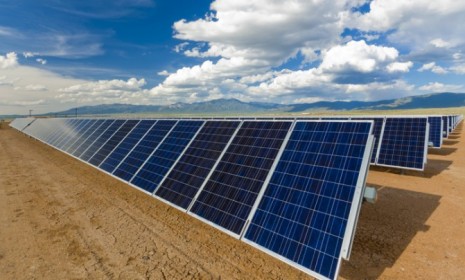The shrinking cost of solar energy: By the numbers
As harnessing the sun's energy becomes cheaper and more efficient, some analysts believe solar will overtake fossil fuels in a matter of decades

According to Moore's Law, the price of computing power is slashed in half every two years — which helps explain why personal computers become outdated so quickly. But now, as Paul Krugman at The New York Times notes, the solar energy industry is experiencing a similar trend. The price of producing solar power continues to fall — thanks to technological improvements and heavy subsidies in countries like China — and this onetime punchline of an energy sector continues to expand. Will solar power eventually overtake oil as Earth's primary energy source? Perhaps. In the meantime, a look at the shrinking cost of solar energy, by the numbers:
65
Percentage growth experienced by the solar energy industry in each of the past five years
The Week
Escape your echo chamber. Get the facts behind the news, plus analysis from multiple perspectives.

Sign up for The Week's Free Newsletters
From our morning news briefing to a weekly Good News Newsletter, get the best of The Week delivered directly to your inbox.
From our morning news briefing to a weekly Good News Newsletter, get the best of The Week delivered directly to your inbox.
7
Percentage decline in the annual price of solar energy, adjusted for inflation
17
Percentage drop in the price of installing solar panels in the U.S. in 2010, says the Washington Post. "Solar companies are figuring out how to set up systems cheaply."
A free daily email with the biggest news stories of the day – and the best features from TheWeek.com
17
Gigawatts of solar power that were created or used in the United States in 2010. That's roughly equivalent to the output of 17 nuclear power plants.
700
Watts of power that the sun shines on every square meter of Earth
89 quadrillion
Watts of power shining on the Earth at any given moment. One quadrillion is a 1 followed by 15 zeros.
15 trillion
Watts of power used by "all of human civilization" each day. It may be a big number, but it's just "one six-thousandth" of the 89 quadrillion watts shining on Earth at any given moment, says Scientific American.
14.5
Seconds it takes for the sun to provide as much energy to Earth as humanity consumes in a day
88
Minutes it takes for the sun to provide as much energy to Earth as humanity consumes in a year
2018
The year that analysts expect solar power to become affordable enough to compete directly with fossil fuels
2060
The year that analysts expect solar power may satisfy more than half of the world's energy needs
$491 billion
Amount that U.S. drivers are expected to spend on gasoline this year
Sources: Forbes, Los Angeles Times, NY Times, Scientific American, Washington Post
-
 What role will Trump play in the battle over Warner Bros. Discovery?
What role will Trump play in the battle over Warner Bros. Discovery?Today’s Big Question Netflix, Paramount battle for the president’s approval
-
 ‘The menu’s other highlights smack of the surreal’
‘The menu’s other highlights smack of the surreal’Instant Opinion Opinion, comment and editorials of the day
-
 Education: More Americans say college isn’t worth it
Education: More Americans say college isn’t worth itfeature College is costly and job prospects are vanishing